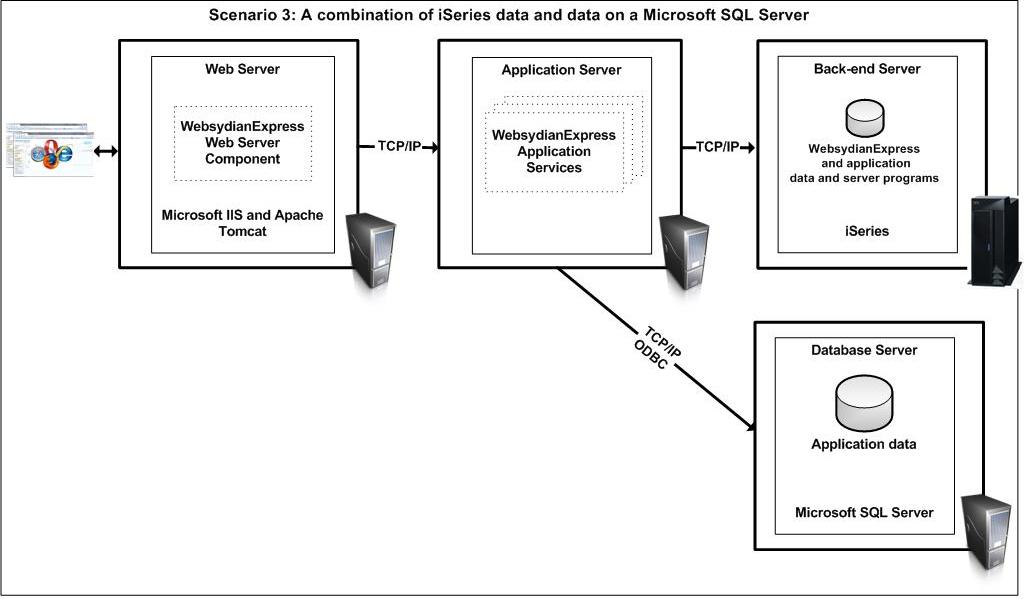|
|
The program you are about to download will help you install WebsydianExpress for iSeries. You must run iSeries V5R3M0 or later in order to install WebsydianExpress for iSeries.
Your iSeries will become the application server of your WebsydianExpress applications and will hold program objects, physical and logical files. You will have a number of options on where to locate your web server.

When developing applications for the WebsydianExpress for iSeries all programs will be required to be RPG objects. You have the choice of using one or more of the following developing tools:
During installation a number of folders, files and objects will be installed on both your pc and your iSeries.
The files installed on your PC is primarily in order to help you transfer and install objects needed on your iSeries. However some important files and resources are available on your PC for later use.
When you run the installation program on your PC, it installs a folder structure on the PC in a location of your choosing.
Default location: C:\Websydian\Express v3.0 for iSeries.
The installation program creates an iSeries library containing the install programs, commands and the save-files containing the application objects. The default name of this library is WXP30INST.
The last part of the installation is running the WXPINST command from this library. This creates a number of libraries:
Default name: WXP30DB
Contains the physical and logical files for the WebsydianExpress application. This library will also contain the EXPRESS job description used by the application service jobs.
The installed files are the ones used by the WebsydianExpress application. It is recommended that you place your own application files in another library.
Default name: WXP30PGM
Contains the program objects used by the WebsydianExpress application. It is recommended that you place your own program objects in another library.
This library also contains the commands to start and stop the WebsydianExpress application.
Default name: WXP30PTF
This library contains any fixes that has been created for the WebsydianExpress application. This library is placed before the program library in the job description.
Default name: WXP30APP
This library is empty after the install. It is part of the EXPRESS job description, so any programs placed in this library can be used by the application.
You can use this for your own application objects - or you can add other libraries to the EXPRESS job description to make them accessible for the application.
Deafult name: WXP30WEB
This library holds required objects if you would like to use the IBM HTTP Server located on your iSeries as the web server for your WebsydianExpress.
Read below for additional information on where to locate your web server.
Default name: WXP30DMO
This library holds a number of objects used by the examples supplied with WebsydianExpress.
If you have an Apache Tomcat server installed on the PC where you install WebsydianExpress, you will get the option to install the web server component used by WebsydianExpress on the Tomcat server. If you select to do so, a servlet will be deployed on the Tomcat server. You will later on be able to select another web server if you like.
An automatic uninstall is not provided with the installation program but you will be able to uninstall by doing the following:
With WebsydianExpress you will get a WebsydianExpress Web Server Component that will handle the communication between your web server and the WebsydianExpress Applications on your Application Server.
For your development environment or testing WebsydianExpress for iSeries for the first time we supply a CGI based WebsydianExpress Web Server Component which integrates into the IBM HTTP Server. This is automatically selected during installation when choosing the default installation. The benefits of the CGI based WebsydianExpress Web Server Component for IBM HTTP Server is the ease of setup and that you do not need to setup a WebSphere prior to testing WebsydianExpress on your iSeries.
The drawback however of the CGI based WebsydianExpress Web Server Component for IBM HTTP Server is the lack of performance.
For your production environment we supply the Java Servlet based WebsydianExpress Web Server Component which requires you to have a Servlet Engine installed on either your iSeries or on a PC Web Server in your network.
Communication between the WebsydianExpress Web Server Component and the WebsydianExpress Applications are done by using TCP/IP. The use of TCP/IP enables you to setup a firewalled environment placing your Web Server inside the demilitarized zone (DMZ) of your network.
We recommend the following Servlet Engines:

Scenario 1: All on one iSeries partition describes the installation where you have installed everything on the same iSeries this is very useful for internal applications not requiring that you setup a DMZ for isolating your Web Server. This scenario is also very useful for a development and test environment.

Scenario 2: Web Server on iSeries partition and the rest
on another iSeries partition is useful if you would like
to separate your Web Server from your Application Server and also
have the ability to establish a DMZ in order to isolate your Web
Server.

Scenario 3: Web Server on Windows Server and the rest on an iSeries partition is most often the approach we see in companies that all ready have established a Web Server or number of Web Servers. This scenario will fit into your existing environment and allow you to isolate the Web Server in a DMZ.
When ready to install follow the document Installing WebsydianExpress for iSeries